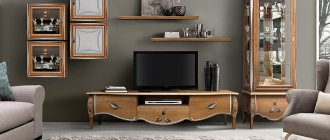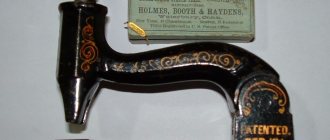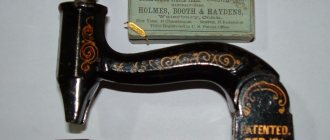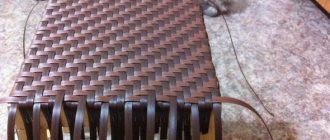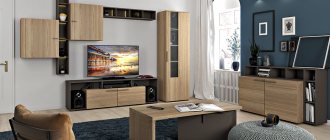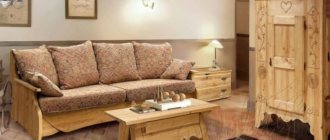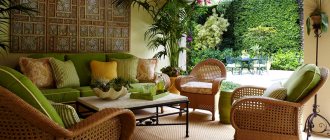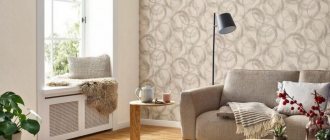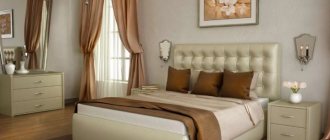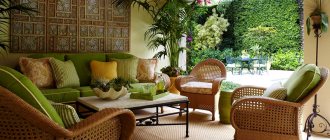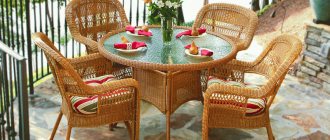Wicker rattan furniture enjoys well-deserved popularity among summer residents and owners of private houses due to its lightness and, at the same time, strength, ease of use and, at the same time, elegance of form.
Rattan furniture can be used both inside the house, where it fits perfectly into various styles from country to loft, and outside: in gazebos, on verandas and in the open air to create a cozy place to relax. In furniture production, both natural and artificial rattan are used.
Rattan: types and applications
Natural rattan is obtained from the stems of the calamus or rattan palm. This is a tropical plant that creeps up towards the sun, twining around tree trunks. The stems of the palm tree, with a height of 80 to 300 meters, are very flexible and strong in structure, while being smooth, without any knots.
In Southeast Asian countries, they are used to build houses, make clothing, accessories, and very durable sticks that were used as contact weapons.
There are many types of rattan palms, which have different characteristics, allowing them to be used for different purposes:
- Himalayan rattan is the shortest type of vine, only 25 meters; lampshades, vases and Indian musical instruments are made from this species.
- The malacca palm , which is weakly flexible and heavy, is used to make umbrella handles and elegant walking canes.
- Rattan of the Tohiti genus is used in furniture production - a light, plastic light stem.
The stems of the rattan palm of the dragon family were used for flogging in the second half of the 19th century in Great Britain, which actively traded with the colonies, and were an extremely popular tool for punishing careless students. Dragon rattan canes had little flexibility and were quite heavy compared to other types of calamus.
- Cerotolobus is a thin, weak, soft vine growing in Malaysia, Borneo, Thailand and the islands of Java and Sumatra. It is used to weave lampshades, carpets and baskets.
- The manau palm grows in Sri Lanka, India and China, as well as Malaysia. This is the most popular type of palm tree for making garden furniture. Its wide and weakly bending stem is boiled for a long time in palm oil to make it more pliable.
- “Devil's Rope” - Daemonorops is suitable for both outdoor, home and restaurant furniture. From the fruits of this palm tree, a special ruby resin is also extracted for varnishing marble and wooden products - “dragon’s blood”.
Properties
Rattan can reach a length of up to 250 meters, for which it is considered one of the longest plants in the whole world. Young shoots are covered with a dense shell of thorns and cling to the trunks of host trees. By spreading their stems from tree to tree, rattan vines create ideal shelters for climbing mammals, birds and other inhabitants of the evergreen rainforest.
At the turn of the 19th–20th centuries, the Russian explorer of the tropics A.N. Krasnov noted that thanks to the ubiquity of rattans, the branches of which are armed with sharp teeth, a walk through the jungle turns out to be “unsafe for a dress.”
There are no lateral branches or shoots along the entire length of the stem. Green, long (up to 2 meters) leaves sway gracefully in the wind. They grow from buds on the trunk and are covered with small, triangular, black spines, each of which is a bent and tilted back hook.
New leaves grow very quickly, wrapping around the tree higher and higher, and the lower ones gradually fall off. The leaves tend to the sun, as its abundance improves the growth of the plant. In their quest for light, rattans rush to capture every illuminated piece of terrain with their stems. They rush into the gaps of human-made paths and cover windows formed as a result of natural tree falls and after felling. The crown of the palm tree remains at the top of the tree, and the restless stem goes down in search of another support. Loops of “devil's ropes” form impenetrable thorny thickets, creating the main obstacle to movement in the tropical jungle. Lianas have an advantage over other forms, which is why climbing and climbing plants are a sign of a tropical forest canopy disturbed by humans.
There are legends about rattan harvesters who, following the shoots of the plant, wandered through the jungle for a week, cutting off pieces of its lashes.
How the stems of a creeping vine turn into garden furniture
In order for the vine stem to turn into a country chair, it is first cleared of leaves and buds, the bark is removed, then it is treated with steam or boiled for 1-2 hours in water with the addition of palm oil, and only after drying a very plastic flexible material suitable for weaving is obtained .
Rattan bark also comes into play; braiding is often made from it.
The material is produced where it grows: in the jungle or on special plantations, and furniture is also woven there. Finished products are coated with varnish or wax.
Only manual labor is used in the production of natural rattan furniture. That is why rattan furniture is quite expensive; the price of products is also affected by the costs of suppliers for delivery of goods.
Features of production technology
Rattan allows for waste-free production. The bark is removed from the plant trunks, then the wood is calibrated by diameter. Next, the wood is placed under the influence of steam and furniture production begins. The bark is cut into equal parts to braid the ends, corners and joints. The remaining material is used to create mats and mats.
The core of the plant is used for openwork weaving. The final product is varnished. The color can be cognac, olive or honey. Next, the product is painted again. The product can be immersed in liquid glass, which will fill all the voids and irregularities. The honey shade is obtained by applying hydrogen peroxide to the product. The varnishes used are water-based, they are polyurethane. The substances do not contain formaldehyde.
What is artificial rattan
The furniture industry also uses cheaper material, which looks as close to natural as possible.
Artificial rattan is a synthetic fiber that is coated with a UV protective agent.
Despite its external similarity, it has properties that make furniture production more economically profitable:
- This analogue is significantly cheaper.
- Unlike natural rattan, which is produced locally, i.e. in Southeast Asia, synthetic rattan is more accessible and popular.
- Compared to natural materials, which are limited in size, polymers can be used to produce fibers of any length. And this significantly increases the variability of design solutions.
Expert opinion
Korzhavin Daniil Dmitrievich
Designer of stylish home furniture
The aluminum frame, which is used in the manufacture of artificial rattan furniture, can withstand weight up to 500 kg
- The material is very durable; it does not lose its presentability even after a long period of use. It can be called almost eternal. Products made from technorattan are not afraid of either rain or snow. It can be left outdoors without fear of damage.
- Unlike furniture made from natural fiber, which uses stronger and thicker vines for the frame, synthetic rattan products are reinforced with a base of wood or metal. This makes the structure heavier, but also makes it more stable.
Required Tools
At the initial stage of work, when a simple product is selected for manufacturing, a minimum of equipment will be required for weaving. To get started, you will need:
- stapler - for attaching rattan to the base if a wooden base is used;
- small pliers;
- small hammer;
- a convenient sharp knife or cutter;
- soldering iron for soldering connecting elements of the material or glue.
It is convenient to work with artificial rattan, as it is flexible and comes in the form of long threads.
In order for the manufacturing process to proceed without unexpected interruptions, it is necessary to take into account the recommendations of experienced craftsmen.
Pros and cons of rattan furniture
There are special requirements for country furniture, which are determined by more complex conditions of use, especially those items that are intended for the street. It is often exposed to weather disasters, so it is important that the furniture does not come apart or fall apart a year after purchase. It should be easy to clean and lightweight so that it is easy to move or bring into the house.
Rattan is the material that best meets all these requirements:
| Lightness and mobility | Rattan furniture is quite light. It doesn’t take a dozen strong men to move it; a weak woman can easily handle it. |
| Durability | The service life of country rattan furniture is up to a quarter of a century. Rattan is not inferior in durability to oak. |
| Easy care | Caring for rattan products is easy. It is enough to protect from prolonged exposure to moisture. If furniture is exposed to rain, it must be dried thoroughly in a dry room with good ventilation. You should not keep it in direct sunlight for a long time to avoid fading and cracks in the varnish coating. Avoid contact with cleaning agents containing acetone. If scratches appear, simply wipe with a cloth soaked in varnish. |
| Strength | Rattan chairs can withstand loads of up to 120 kg, sofas - up to 160 kg, and this is despite their external elegance and even fragility. |
| Temperature stability | Rattan is not affected by temperature changes. It does not crack from frost, does not melt from heat. |
| Variety of design solutions | Rattan can be used to create furniture of any shape and size. |
| Versatility | Rattan furniture is also used indoors and can serve as part of landscape design and decorate balconies and verandas. Rattan sofas, armchairs and tables fit into any interior. They are often used in restaurants and outdoor cafes. |
| Eco-friendly and natural | Products made from natural fibers do not harm the environment: cutting down palm trees is officially permitted and is environmentally friendly; the manufacture of rattan furniture does not use harmful substances and manual labor is used. When used, these products have a beneficial effect on the human body, since they have the positive energy of natural material. |
A chair made of natural rattan seems to adapt to the person who sits in it, following the curves of the body due to the fact that the rattan fibers slightly diverge under the influence of weight. But after the person sitting gets up, the rattan rods return to their previous position.
The only negative that can be mentioned is the rather high cost of the products, although, in fairness, it should be noted that it is completely justified.
Care
The rattan palm is light-loving and grows better in bright light. The plant is also heat-loving, but does not tolerate drafts, and the root is very sensitive to cold air.
The optimal temperature for growing palm trees is + 250C. The surface on which the pot with the plant stands should be at room temperature, but in no case cold.
Rattan needs loose soil that is easily permeable to water and air , which contains the maximum amount of nutrients.
The palm tree is a moisture-loving plant and grows well with a high moisture content in the air, which can be achieved by using special air humidifiers or by placing containers of water near the plant.
Leaves need to be sprayed from different sides in summer and spring. In autumn and winter, spraying is stopped to avoid the formation of fungi. The leaves must sometimes be wiped with a soft sponge and washed with warm water. Yellow leaves need to be cut off, but only when the leaf is completely dry. The tips of the leaves cannot be cut off, as they will begin to dry out faster. Rattan leaves grow rather slowly and if you do not take care of them, the plant may lose all its leaves.
to water the rattan palm with water purified from various impurities. Ordinary untreated water saturates the soil with salts harmful to plants.
The water temperature should be at room temperature to prevent root rot. Water without the required purification for irrigation must be left for at least a day to evaporate chlorine, which palm trees especially dislike. Excess water should drain through the drainage holes in the pot. Although Rattan is a moisture-loving plant, excess water can cause oxygen starvation and death of the plant as a whole.
While the palm tree is small, it needs to take a warm shower in the bathroom to prevent the appearance of spider mites. Palm trees need fertilizer during active growth. Fertilizers should be poured directly into the ground or by spraying the leaves with a special solution.
The rattan palm should be watered at least once a week in summer, and once every two weeks in winter.
vegetatively . A new palm tree can only be grown from seeds. They are usually sown at the end of winter or early spring. You cannot cut the top of the stem, as the palm tree may die.
be replanted once every few years. The palm tree is transferred from one pot to another with a lump of earth in order to preserve the roots. The new pot should exceed the size of the previous one by 20 - 25%. The palm tree must be replanted, otherwise it will lose all its beauty and begin to stop growing.
Despite the slow growth of the palm tree, it reaches large sizes, and it is advisable to grow it in spacious rooms.
What to look for when choosing rattan furniture
To choose high-quality furniture that will last a long time, we pay attention to several aspects that affect the performance characteristics of the products.
Manufacturer country
There are many furniture factories in Southeast Asia that produce rattan furniture. Among them, better quality products come from Malaysian factories.
Rattan classification
The higher the class of rattan furniture, the more durable and high quality it is:
What kind of rattan furniture would you buy for yourself?
NaturalArtificial
- Products class A. In production, the thickest stems with small pores are used, the cut color is light.
- Class B - the stems are slightly smaller in diameter, the cut area is slightly darker, the pores are slightly larger.
- Class C - stems are thin, porous, often with structural defects in the form of specks and darkening, the cut area is the darkest.
Externally, products of the first two classes may be almost identical, but their performance characteristics will be different.
Expert opinion
Korzhavin Daniil Dmitrievich
Designer of stylish home furniture
To reduce the cost of the product, manufacturers use rattan of the highest A class together with lower class B rattan, using more durable and high-quality material for the manufacture of the frame. As a rule, if combined correctly, this does not affect the technical properties of the product.
Photo
Photos of the longest plant - the Rattan palm.
We recommend looking at photos and learning about the features of growing coconut, date, screw (Pandanus), Madagascar (Raffia) palms, as well as tropical plants such as Dracaena, Gomuti, Howea, Chrysalidocarpus, Rapis and Chamerops.
How to choose technorattan furniture for your garden
It is believed that it is not difficult to choose furniture made from artificial fiber; it is enough to visually inspect the model to understand whether it is suitable or not. Polymer pieces of furniture are not divided into classes and the name of the manufacturer is unlikely to say anything significant about their quality.
The popularity of synthetic rattan has become an indirect reason for the appearance on the market of a very large number of low-quality products.
In order for technorattan furniture to serve for a long time, it is worth taking into account the following:
- What is the frame made of ? The most popular solutions for strengthening the structure are bases made of steel, aluminum or cast plastic frames. Aluminum bases should not be thin as they are not durable. Steel frames are not advisable if the furniture is intended to be used in the garden, not under cover, as they will corrode over time.
- The degree of fiber tension in woven products . Simple pressure can determine the degree of resistance; the weave itself should not bend under pressure.
- Weave fiber density . The closer together the rattan fibers are, the stronger the product. Sometimes it is better to choose furniture with additional reinforcement located on the inside in the form of a metal mesh or other fastening elements.
Furniture made of synthetic fiber should have only one joint, only then can it be considered high quality. There should be no burrs or cracks on the surface of the products.
Conclusions: briefly
What is really better: artificial or natural rattan?
- If you want harmony with nature, choose natural rattan. Yes, you will have to monitor the condition of the furniture, but it’s worth it.
- If you want carefree comfort, choose artificial.
View "Rattan Furniture"
What style is it suitable for?
Many people are sure that wicker furniture looks great in any interior style, but there are style trends in which it is most relevant:
- country - this style trend is characterized by a cozy, romantic atmosphere of a rural house. Wicker chairs, a sofa, table lamps and coffee tables, chests and baskets - all this fits organically into country style. The colors of the furniture will be determined by the ethnic color of the design: for Latin American or African country style, you should prefer olive green, light yellow shades, and for Provence and English country - white, brown, gray tones;
- colonial style - interiors in a similar design solution combine light shades of furniture with carved floral patterns, wicker and twisted details. Chests, baskets, and wicker rattan tables are suitable for the colonial style;
- eco style - the main advantages of rattan perfectly suit the eco style, which is characterized by the use of exclusively natural materials.
Colonial
Eco style
Country
